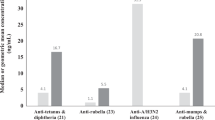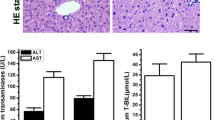Abstract
A paucity of data exists to corroborate the few studies that report immune suppression after exposure to perfluorooctanesulfonate (PFOS). In this study, adult male C57BL/6 mice were exposed to PFOS daily via gavage for 60 days [0, 0.5, 5, 25, 50, or 125 mg/kg total administered dose (TAD)]. The results showed that liver mass was significantly increased at ≥5 mg PFOS/kg TAD and in a dose-dependent manner. Lymphocyte proliferation and natural killer cell activity were altered in male mice. Plaque forming cell (PFC) response was suppressed beginning at 5 mg/kg TAD. Based on the liver mass and PFC response, the no observed adverse effect level and lowest observed adverse effect level for male mice exposed PFOS for 60 days was 0.5 and 5 mg/kg TAD, respectively. Measured PFOS serum concentrations at these dose levels were 0.674 ± 0.166 and 7.132 ± 1.039 mg/l, respectively. These results indicate that PFOS exposure can affect the immunity function in mice at levels approximately 50-fold for highly exposed human populations.







Similar content being viewed by others
References
3M Company (2002) 104-Week dietary chronic toxicity and carcinogenicity study with perfluorooctane sulfonic acid potassium salt (PFOS; T-6295) in rats. Final Report 3M T-6295 (Covance study no. 6329-183), vols I–IX. 3M, St Paul, 4068 p
Abbott BD (2008) Review of the expression of peroxisome proliferators activated receptors alpha (PPARalpha), beta (PPARbeta), and gamma (PPARgamma) in rodent and human development. Reprod Toxicol. doi:10.1016/j.reprotox.2008.10.001
Alexander BH, Olsen GW, Burris JM, Mandel JH, Mandel JS (2003) Mortality of employees of a perfluorooctanesulphonyl fluoride manufacturing facility. Occup Environ Med 60:722–729
Ankley GT, Kuehl DW, Kahl MD, Jensen KM, Linnum A, Leino RL, Villeneuvet DA (2005) Reproductive and developmental toxicity and bioconcentration of perfluorooctanesulfonate in a partial life-cycle test with the fathead minnow (Pimephales promelas). Environ Toxicol Chem 24:2316–2324
Butenhoff JL, Olsen GW, Pfahles-Hutchens A (2006) The applicability of biomonitoring data for perfluorooctanesulfonate to the environmental public health continuum. Environ Health Perspect 114:1776–1782
Calafat AM, Kuklenyik Z, Reidy JA, Caudill SP, Tully JS, Needham LL (2007) Serum concentrations of 11 polyfluoroalkyl compounds in the U.S. population: data from the national health and nutrition examination survey (NHANES). Environ Sci Technol 41:2237–2242
Chang SC, Thibodeaux JR, Eastvold ML, Ehresman DJ, Bjork JA, Froehlich JW, Lau C, Singh RJ, Wallace KB, Butenhoff JL (2008) Thyroid hormone status and pituitary function in adult rats given oral doses of perfluorooctanesulfonate (PFOS). Toxicology 243:330–339
Cunard R, DiCampli D, Archer DC, Stevenson JL, Ricote M, Galss CK, Kelly CJ (2002) WY14,643, an PPAR alpha ligand, has profound effects on immune responses in vivo. J Immunol 169:6806–6812
de Vos MG, Huijbregts MA, van den Heuvel-Greve MJ, Vethaak AD, Van de Vijver KI, Leonards PE, van Leeuwen SP, de Vooqt P, Hendriks AJ (2008) Accumulation of perfluorooctane sulfonate (PFOS) in the food chain of the Western Scheldt estuary: comparing field measurements with kinetic modeling. Chemosphere 70:1766–1773
DeWitt JC, Copeland CB, Strynar MJ, Luebke RW (2008) Perfluorooctanoic acid-induced immunomodulation in adult C57BL/6J or C57BL/6N female mice. Environ Health Perspect 116:644–650
Francis J, MohanKumar SMJ, MohanKumar PS (2000) Correlations of norepinephrine release in the paraventricular nucleus with plasma corticosterone and leptin after systemic lipopolysaccharide: blockade by soluble IL-1 receptor. Brain Res 867:180–187
Giesy JP, Kannan K (2001) Global distribution of perfluorooctane sulfonate in wildlife. Environ Sci Technol 35:1339–1342
Hansen KJ, Clemen LA, Ellefson ME, Johnson HO (2001) Compound-specific, quantitative characterization of organic fluorochemicals in biological matrices. Environ Sci Technol 35:766–770
Hart K, Kannan K, Isobe T, Takahashi S, Yamada TK, Miyazaki N, Tanabe S (2008) Time trends and transplacental transfer of perfluorinated compounds in melon-headed whales stranded along the Japanese coast in 1982, 2001/2002, and 2006. Environ Sci Technol 42:7132–7137
Houde M, Bujas TA, Small J, Wells RS, Fair PA, Bossart GD, Solomon KR, Muir DC (2006) Biomagnification of perfluoroalkyl compounds in the bottlenose dolphin (Tursiops truncatus) food web. Environ Sci Technol 40:4138–4144
Jerne NK, Nordin AA (1963) Plaque formation in agar by single antibody-producing cells. Science 140:405
Jin Y, Saito N, Harada KH, Inoue K, Koizumi A (2007) Historical trends in human serum levels of perfluorooctanoate and perfluorooctane sulfonate in Shenyang, China. Tohoku J Exp Med 212:63–70
Keil DE, Mehlmann T, Butterworth L, Peden-Adams MM (2008) Gestational exposure to perfluorooctane sulfonate suppresses immune function in B6C3F1 mice. Toxicol Sci 103:77–85
Lau C, Anitole K, Hodes C, Lai D, Pfahles-Hutchens A, Seed J (2007) Perfluoroalkyl acids: a review of monitoring and toxicological findings. Toxicol Sci 99:366–394
Lefebvre DE, Curran I, Armstrong C, Coady L, Parenteau M, Liston V, Barker M, Aziz S, Rutherford K, Bellon-Gagnon P, Shenton J, Mehta R, Bondy G (2008) Immunomodulatory effects of dietary potassium eprfluorooctane sulfonate (PFOS) exposure in adult Sprague-Dawley Rats. J Toxicol Environ Health A 71:1516–1525
Martin MT, Brennan RJ, Hu W, Avanoqlu E, Lau C, Ren H, Wood CR, Corton JC, Kavlock RJ, Dix DJ (2007) Toxicogenomic study of triazole fungicides and perfluoroalkyl acids in rat livers predicts toxicity and categorizes chemicals based on mechanisms of toxicity. Toxicol Sci 97:595–613
Monroy R, Morrison K, Teo K, Atkinson S, Kubwabo C, Stewart B, Foster WG (2008) Serum levels of perfluoroalkyl compounds in human maternal and umbilical cord blood samples. Environ Res 108:56–62
Olsen GW, Church TR, Miller JP, Burris JM, Hansen KJ, Lundberg JK, Armitage JB, Herron RM, Medhdizadehkashi Z, Nobiletti JB, O’Neill EM, Mandel JH, Zobel LR (2003) Perfluorooctanesulfonate and other fluorochemicals in the serum of American Red Cross adult blood donors. Environ Health Perspect 111:1892–1901
Organization for Economic Co-operation and Development (2002) Hazard assessment of perfluorooctane sulfonate (PFOS) and its salts. Available at: http://www.oecd.org/dataoecd/23/18/2382880.pdf
Peden-Adams MM, EuDaly JG, Dabra S, EuDaly A, Heesemann L, Smythe J, Keil D (2007) Suppression of humoral immunity following exposure to the perfluorinated inseticide sulfluramid. J Toxicol Environ Health A 70:1130–1141
Peden-Adams MM, Keller JM, EuDaly JG, Berger J, Gilkeson GS, Keil DE (2008) Suppression of humoral immunity in mice following exposure to perfluorooctane sulfonate. Toxicol Sci 104:144–154
Shipley JM, Hurst CH, Tanaka SS, DeRoos FL, Butenhoff JL, Seacat AM, Waxman DJ (2004) Trans-activation of PPARalpha and induction of PPAR alpha target genes by perfluorooctane-based chemicals. Toxicol Sci 80:151–160
Tittlemier SA, Pepper K, Seymour C, Moisey J, Bronson R, Cao XL, Dabeka RW (2007) Dietary exposure of Canadians to perfluorinated carboxylates and perfluorooctane sulfonate via consumption of meat, fish, fast foods, and food items prepared in their packaging. J Agric Food Chem 55:3203–3210
U.S. EPA (U.S. Environmental Protection Agency) (2006) SAB review of EPA’s draft risk assessment of potential human health effects associated with PFOA and its salts. Available at: http://yosemite.epa.gov/sab/sabpeople.nsf/WebCommittees/BOARD
Vestergren R, Cousins IT, Trudel D, Wormuth M, Scheringer M (2008) Estimating the contribution of precursor compounds in consumer exposure to PFOS and PFOA. Chemosphere 73:1617–1624
Wu R, Coleman N, Stanley M (1996) Different susceptibility of cervical keratinocytes containing human papillomavirus to cellmediated cytotoxicity. Chin Med J 109:854–858
Yang Q, Xie Y, DePierre JW (2000) Effects of peroxisome proliferators on the thymus and spleen of mice. Clin Exp Immunol 122:219–226
Yang Q, Xie Y, Eriksson AM, Nelson BD, DePierre JW (2001) Further evidence for the involvement of inhibition of cell proliferation and development in thymic and splenic atrophy induced by the peroxisome proliferator perfluorooctanoic acid in mice. Biochem Pharmacol 62:1133–1140
Yang Q, Abedi-Valugerdi M, Xie Y, Zhao X-Y, Möller G, Nelson BD, Depierre JW (2002) Potent suppression of the adaptive immune response in mice upon dietary exposure to the potent peroxisome proliferator, perfluorooctanoic acid. Int Immunopharmacol 2:389–397
Zheng L, Dong GH, Jin YH, He QC (2008) Immunotoxic changes associated with a 7-day oral exposure to perfluorooctanesulfonate (PFOS) in adult male C57BL/6 mice. Arch Toxicol. doi:10.1007/s00204-008-0361-3
Acknowledgments
This research was supported by Grants from the National Natural Science Foundation of China (20707041 and 20837004) and Grants from the Research Found for the Doctor Program of Higher Education (20070159015).
Author information
Authors and Affiliations
Corresponding authors
Rights and permissions
About this article
Cite this article
Dong, GH., Zhang, YH., Zheng, L. et al. Chronic effects of perfluorooctanesulfonate exposure on immunotoxicity in adult male C57BL/6 mice. Arch Toxicol 83, 805–815 (2009). https://doi.org/10.1007/s00204-009-0424-0
Received:
Accepted:
Published:
Issue Date:
DOI: https://doi.org/10.1007/s00204-009-0424-0




